Microsoft Surface Pro Review
by Anand Lal Shimpi on February 5, 2013 9:00 PM ESTSurface Pro as a Tablet
If you can get over the bulk, Surface Pro is easily the fastest tablet on the market today. Apple has done a great job of making relatively slow hardware feel very fast with iOS, but Surface Pro brute forces its way to the top. Web pages load quicker than on any ARM based tablet and multitasking is just awesome on the device. This is where the power of Intel’s Core microarchitecture really comes into play.
Since the introduction of the 3rd generation iPad with Retina Display several folks have pointed out to me that UI frame rate isn’t always so smooth on the device. I personally never noticed because I found that most of the competition was even worse, so it always seemed relatively smooth to me. After playing with Surface Pro however and going back to even the 4th gen iPad all of the sudden frame rate stutters are much more noticeable. Playing around with Bing maps on Surface Pro vs. RT is like night and day. Even if you compare scrolling and zoom performance to native iOS maps on the iPad 4, Surface Pro wins out.
Scrolling in web pages, application install time, file copy time, everything is just significantly faster on Surface Pro than on any competing tablet. Oh, and it boots (from full power off) in less than 10 seconds. It’s really the combination of the great CPU performance and fast SSD that deliver the responsiveness of the Surface Pro.
We’re still lacking good cross-platform performance tests, but there are a few browser based benchmarks that I can use to highlight just how much faster Surface Pro is compared to anything ARM based on the market today:
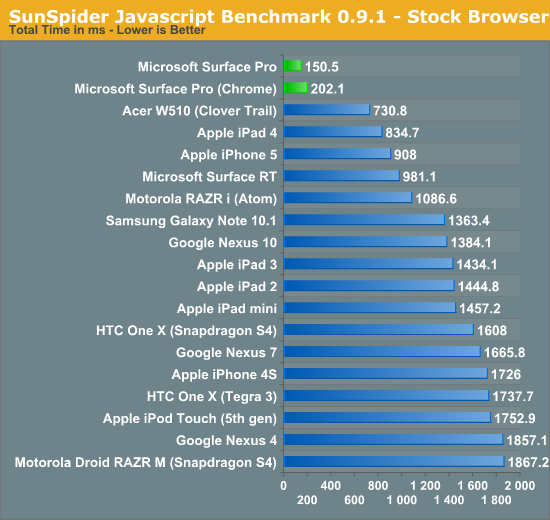
SunSpider is our tried and true quick js benchmark, and here we see huge scaling as we move to Intel's Core i5. Regardless of browser used you're seeing a significant improvement in performance that directly translates to faster web page load times.
Moving on we have Kraken, a seriously heavy javascript benchmark built by Mozilla. Kraken focuses on forward looking applications that are potentially too slow to run in modern browsers today. The result is much longer run times than anything we've seen thus far, and a very CPU heavy benchmark:
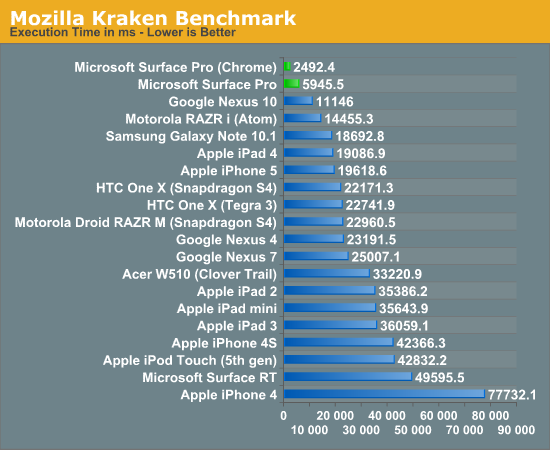
Even when handcuffed by modern IE10 you're looking at almost twice the performance of the Nexus 10. Level the playing field with Chrome as a browser and now Surface Pro completes the test in a bit more than 1/8 of the time of the iPad 4, or 1/4 of the time of the Nexus 10.
Surface Pro manages to deliver almost 5x the performance of the iPad 4 here.
We have one last web-based benchmark: WebXPRT by Principled Technologies (PT). WebXPRT measures performance in four HTML5/js workloads:
Photo Effects: Measures the time to apply effects to a set of six photos. The filters are Sharpen, Emboss, and Glow. WebXPRT applies each filter to two photos. This test uses HTML5 Canvas 2D and JavaScript.
Face Detect: Measures the average time to check for human faces in a photo. WebXPRT runs this test on five photos and uses the average time to calculate the final result. This test uses HTML5 Canvas 2D to get access to photo data. The detection algorithm is implemented in JavaScript.
Stocks Dashboard: Measures the time to calculate financial indicators of a stock based on historical data and display the result in a dashboard. The calculations are done in JavaScript, and the calculated stocks data is displayed using HTML tables and Canvas 2D.
Offline Notes: Measures the time to store notes securely in the browser's HTML5 local storage and display recent entries. This test uses using AES for security.
We're reporting the overall score after all tests have been run:
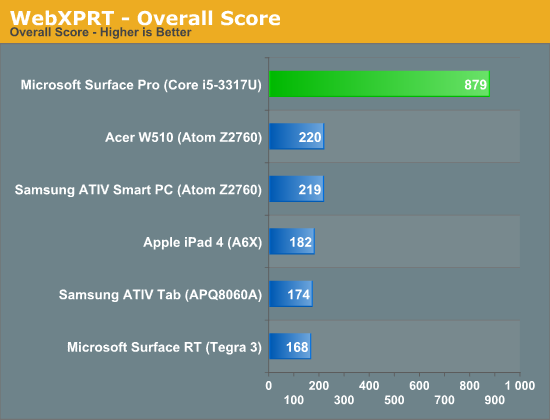
Next up are another set of benchmarks from PT, but unlike the WebXPRT suite these tests don't run in a browser. Once again we're looking at performance in a handful of tasks designed to stress the CPU. Here the performance advantage continues to be quite significant. While Surface RT and the other Windows RT/8 devices still feel a bit sluggish, I have no performance complaints whatsoever about Surface Pro:

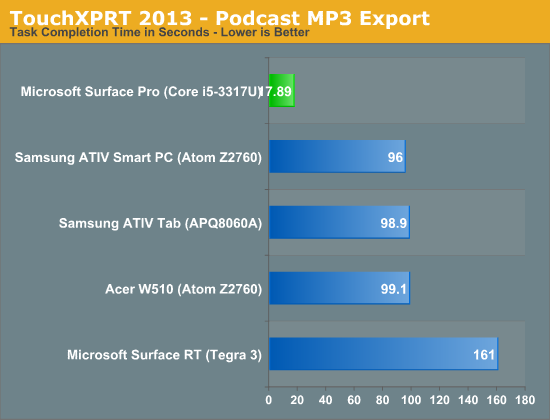
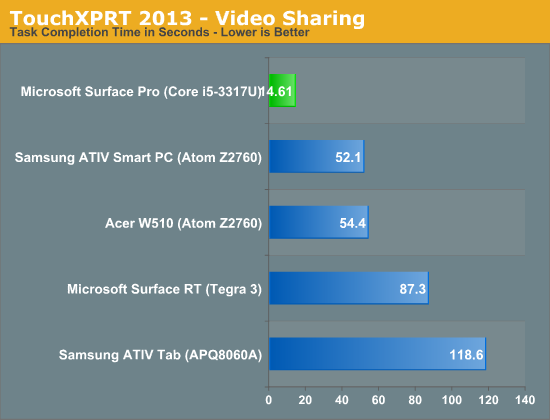
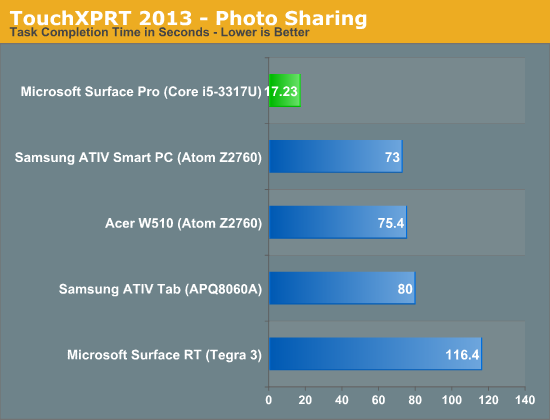
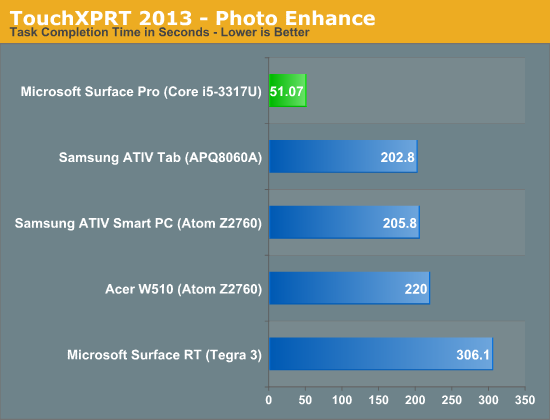
If I had any complaints about using Surface Pro as a tablet outside of weight, they’d be about Windows 8. There are still far too many bugs and quirks in the OS that just don’t make sense. I’ve outlined some of my issues with Windows 8 before. I think the UI works just fine for a tablet, it’s just the unfinished touches that need attention. For example, having to gesture in modern IE10 before being able to switch between tabs seems silly.

This still happens way too often in the Windows Store, no indication of what's going on just a blank screen
On the bug-front, all too often I’ll wake up the system only to have the lock screen upside down. And despite all of the extra performance under the hood, the time from when you hit the power/lock button to when something appears on the screen is just longer than on an iPad or Android tablet. We’re not talking several seconds, but it’s still noticeably longer.










228 Comments
View All Comments
WCHS - Wednesday, February 6, 2013 - link
Sorry Anand, this is not the only solution. The best solution to this question is Ipad Mini + Ultrabook. I hate it when companies try to combine two good things and end up with one bad one. I don't even notice my Mini being in my ultrabook bag. I get both - I get long battery life, ultimate portability, full applications access when I need it, and can even use both at the same time - for the almost the same price as Surface Pro + keyboard.andrewaggb - Wednesday, February 6, 2013 - link
but you have the downside of your data being split between multiple devices... you download your mail twice, your music twice, whatever it is you work on twice... or you do entirely different things on both so there is no overlap.Or you read an email on your tablet because it's more convenient (this happens to me all the time), but you need to respond and you need to type a fair amount and sometimes include files or content that's on your laptop. So you end up switching devices. Maybe it's just me, but this happens to me a lot.
I'm not sure if surface pro is quite good enough yet, it's unclear to me whether it can drive two external monitors and I'd really rather have 256gb of internal storage. So maybe surface pro 2. I'd happily give up a separate laptop + tablet. Just like I happily gave up mp3 player + phone and often use my camera phone instead of my nice DSLR. Convenience will win in the end.
WCHS - Thursday, February 7, 2013 - link
No, that is the point - you mostly do "different things" on the two devices. Even for the common things - at least they are possible. A Surface Pro will never be an ereader. The other point is that the Ipad Mini has shown that the sweet spot for a handheld tablet is "smaller, especially lighter " than an Ipad 2,3,4 - not heavier. Thats it - the Surface Pro is not "handheld".andrewaggb - Thursday, February 7, 2013 - link
Could be right. I'm certainly not unhappy with the size or weight of my ipad, but it also rarely leaves my house.I could take a 7" tablet with me easily... but I recently bough a galaxy note 2, which is another hybrid device, and I personally quite like it.
I could see myself liking the surface pro for many of the same reasons I like the note 2. But it sounds like the current surface pro isn't quite there yet.
flyingpants1 - Wednesday, February 6, 2013 - link
I'd like to see a roundup comparing Win8 i5 convertibles, namely the Surface Pro, the Samsung Ativ 700T, the Dell XPS 12 (the one that has a crazy swinging flippy hinge), the Lenovo Yoga 13, the Asus ones, Taichi and the others.All of these devices have severe drawbacks.
The Surface pro is heavy and has no real keyboard or stand. The storage issue is a big joke. Probably the worst option of all.
The Yoga 13 is large, heavy and the keyboard is exposed.
The Dell XPS 12 is a slightly smaller Yoga and the keyboard isn't exposed on tablet mode.
The Ativ 700T is my favourite so far. Too bad it has a poor connection between the screen and dock..
I think each manufacturer should make a 10", 11", 13" of their tablets. IMHO 13.3" 1080p is more than enough to replace a 15.6".
faizoff - Wednesday, February 6, 2013 - link
"The Surface pro is heavy and has no real keyboard or stand. The storage issue is a big joke. Probably the worst option of all."Just curious what is the big joke about storage? It's plainly listed what you're going to get and like any other windows OS you can experiment on your own to maximize space.
Doominated - Wednesday, February 6, 2013 - link
Lol, if you think the Surface Pro has a "storage problem" you should try checking out some Yogapad setups. I've seen as little as 60 gigs partitioned to the C Drive out of the box.Sorry to break it to you, but the Surface Pro only has a storage space issue if you have absolutely no clue what you're doing with Windows. It takes all of 10 minutes to get yourself up to almost 100 GB of usable storage. Even more if you buy an mSDXC card.
Death666Angel - Wednesday, February 6, 2013 - link
I liked the review overall. And I hope you make a video review for this as well. :DThat said, I did notice some oddities.
First, I find it strange that you compare this so much to ARM based tablets. To me, there is a mountain between those 2 kinds of devices. The comparison to Ultrabooks is much more apt. :)
Secondly, the way you treat calibrated displays. You state:
"Given that the majority of users don’t do any color calibration on their PCs, this becomes a real problem for consumer perception if your tablet doesn’t ship with accurate colors by default."
All I have read on that issue is that our eyes are pretty good at adjusting to different color schemes. So unless you use one device that is calibrated exactly and one that is off, you will not notice a device being "wrong". So for most people, it is a non-issue. Then, you praise Apple for doing the calibration, which is fine because it is an extra service they provide (how much value it is to the standard customer is another matter). But what you don't say is that calibration is not eternal. At least everything I've read on the issue says that you have to calibrate displays every few weeks in order to ensure the continued accuracy of the results. Do tablet/laptop displays operate differently where they don't need recalibration down the road? Because if they do need recalibration, than that whole first calibration is looking much less desirable to me. If I need accurate colors, I have the necessary tools to get it myself. If I don't need it a simple calibration by eye is enough to give me a good result (compare the picture to my PC or TV monitor so that everything looks equal and is easy on the eyes).
Thirdly, your desire for TB. That is simply a personal taste thing and you make that very clear, so I have nothing to criticize. :D I just wanted to say that I do not look at a TB port when buying my PC stuff. The TB enabled things out there are not for me (too expensive, too useless), it adds cost and energy consumption to devices. So I'm pretty happy that MS isn't supporting it here. Unless it comes integrated in the PCH, I don't want it.
That's all I wanted to say. :)
Death666Angel - Wednesday, February 6, 2013 - link
Oh, one thing more: Please add metric units to the imperial ones. :)Death666Angel - Wednesday, February 6, 2013 - link
Damn, forgot something else: I'm really disappointed by the power adapter. I would like to see everything that is in a reasonable power envelope (sub 60W) to use a PSU attached to the plug (for the wall socket) and not half way between the plug for the wall socket and the device plug.